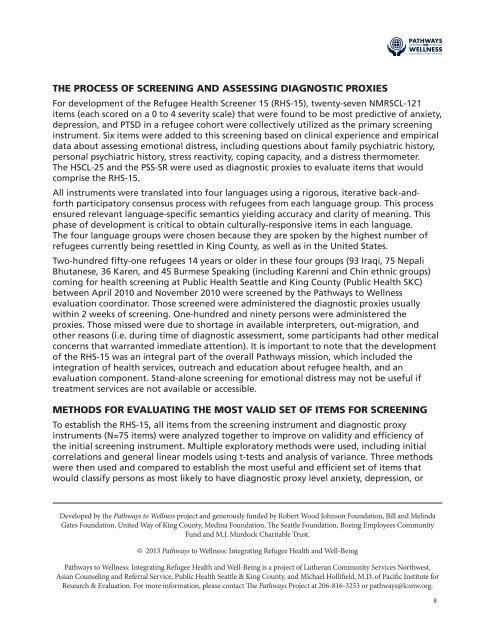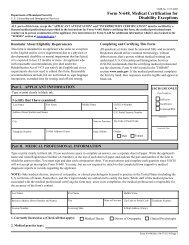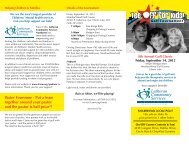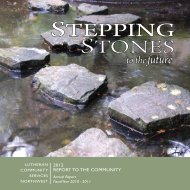to download the Refugee Health Screener Tool - Lutheran ...
to download the Refugee Health Screener Tool - Lutheran ...
to download the Refugee Health Screener Tool - Lutheran ...
Create successful ePaper yourself
Turn your PDF publications into a flip-book with our unique Google optimized e-Paper software.
THE PROCESS OF SCREENING AND ASSESSING DIAGNOSTIC PROXIES<br />
For development of <strong>the</strong> <strong>Refugee</strong> <strong>Health</strong> <strong>Screener</strong> 15 (RHS-15), twenty-seven NMRSCL-121<br />
items (each scored on a 0 <strong>to</strong> 4 severity scale) that were found <strong>to</strong> be most predictive of anxiety,<br />
depression, and PTSD in a refugee cohort were collectively utilized as <strong>the</strong> primary screening<br />
instrument. Six items were added <strong>to</strong> this screening based on clinical experience and empirical<br />
data about assessing emotional distress, including questions about family psychiatric his<strong>to</strong>ry,<br />
personal psychiatric his<strong>to</strong>ry, stress reactivity, coping capacity, and a distress <strong>the</strong>rmometer.<br />
The HSCL-25 and <strong>the</strong> PSS-SR were used as diagnostic proxies <strong>to</strong> evaluate items that would<br />
comprise <strong>the</strong> RHS-15.<br />
All instruments were translated in<strong>to</strong> four languages using a rigorous, iterative back-andforth<br />
participa<strong>to</strong>ry consensus process with refugees from each language group. This process<br />
ensured relevant language-specific semantics yielding accuracy and clarity of meaning. This<br />
phase of development is critical <strong>to</strong> obtain culturally-responsive items in each language.<br />
The four language groups were chosen because <strong>the</strong>y are spoken by <strong>the</strong> highest number of<br />
refugees currently being resettled in King County, as well as in <strong>the</strong> United States.<br />
Two-hundred fifty-one refugees 14 years or older in <strong>the</strong>se four groups (93 Iraqi, 75 Nepali<br />
Bhutanese, 36 Karen, and 45 Burmese Speaking (including Karenni and Chin ethnic groups)<br />
coming for health screening at Public <strong>Health</strong> Seattle and King County (Public <strong>Health</strong> SKC)<br />
between April 2010 and November 2010 were screened by <strong>the</strong> Pathways <strong>to</strong> Wellness<br />
evaluation coordina<strong>to</strong>r. Those screened were administered <strong>the</strong> diagnostic proxies usually<br />
within 2 weeks of screening. One-hundred and ninety persons were administered <strong>the</strong><br />
proxies. Those missed were due <strong>to</strong> shortage in available interpreters, out-migration, and<br />
o<strong>the</strong>r reasons (i.e. during time of diagnostic assessment, some participants had o<strong>the</strong>r medical<br />
concerns that warranted immediate attention). It is important <strong>to</strong> note that <strong>the</strong> development<br />
of <strong>the</strong> RHS-15 was an integral part of <strong>the</strong> overall Pathways mission, which included <strong>the</strong><br />
integration of health services, outreach and education about refugee health, and an<br />
evaluation component. Stand-alone screening for emotional distress may not be useful if<br />
treatment services are not available or accessible.<br />
METHODS FOR EVALUATING THE MOST VALID SET OF ITEMS FOR SCREENING<br />
To establish <strong>the</strong> RHS-15, all items from <strong>the</strong> screening instrument and diagnostic proxy<br />
instruments (N=75 items) were analyzed <strong>to</strong>ge<strong>the</strong>r <strong>to</strong> improve on validity and efficiency of<br />
<strong>the</strong> initial screening instrument. Multiple explora<strong>to</strong>ry methods were used, including initial<br />
correlations and general linear models using t-tests and analysis of variance. Three methods<br />
were <strong>the</strong>n used and compared <strong>to</strong> establish <strong>the</strong> most useful and efficient set of items that<br />
would classify persons as most likely <strong>to</strong> have diagnostic proxy level anxiety, depression, or<br />
Developed by <strong>the</strong> Pathways <strong>to</strong> Wellness project and generously funded by Robert Wood Johnson Foundation, Bill and Melinda<br />
Gates Foundation, United Way of King County, Medina Foundation, The Seattle Foundation, Boeing Employees Community<br />
Fund and M.J. Murdock Charitable Trust.<br />
© 2013 Pathways <strong>to</strong> Wellness: Integrating <strong>Refugee</strong> <strong>Health</strong> and Well-Being<br />
Pathways <strong>to</strong> Wellness: Integrating <strong>Refugee</strong> <strong>Health</strong> and Well-Being is a project of Lu<strong>the</strong>ran Community Services Northwest,<br />
Asian Counseling and Referral Service, Public <strong>Health</strong> Seattle & King County, and Michael Hollifield, M.D. of Pacific Institute for<br />
Research & Evaluation. For more information, please contact The Pathways Project at 206-816-3253 or pathways@lcsnw.org.<br />
8





